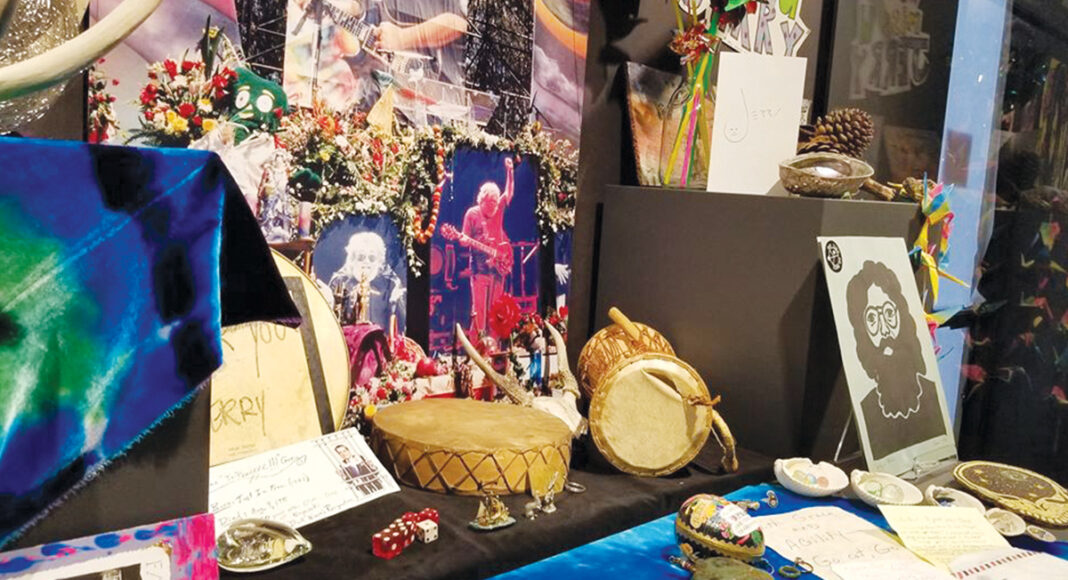The Grateful Dead is known primarily for their music and the massive cultural impact it has left over the last 50 years. But Northern California’s most famous cultural export has also made its mark in the world of visual art, inspiring thousands of artists in distinctly non-musical expressions.
The proof is there for examination in a new exhibit at UCSC’s Dead Central at the McHenry Library, titled When We Paint Our Masterpiece: The Art of the Grateful Dead Community.
The exhibit is drawn, of course, from UCSC’s Grateful Dead Archive, an enormous cache of fan correspondence, business records, photographs, artifacts and other ephemera donated by the band itself. The collection of material is large enough, in fact, that the McHenry Library’s Special Collections has been drawing individual exhibits from it for a dozen years.
The latest focuses on the artwork of the Dead’s fan community, as rendered on envelopes, letters, and other correspondence dating back close to the band’s beginnings. Perhaps more than any other popular musical entity, the Grateful Dead has been associated with a wide variety of instantly recognizable visual iconography, from the skeleton with the headdress made of roses (known as “Bertha” in Dead circles) to the multi-colored conga lines of dancing bears, to the stylized images of Dead guitarist and frontman Jerry Garcia. This Dead imagery is in ample display in the new exhibit, but it goes well beyond those familiar icons, as well.
The new exhibit was inspired by research from UCSC graduate student Wyatt Young into international Grateful Dead fan communities, says Jessica Pigza, the outreach and exhibits librarian at UCSC’s Special Collections.
“[Young] discovered this amazing concentration of artwork from Japan,” says Pigza, “which was a country where the Dead never toured. But there was still a really strong Japanese Deadhead community there. So we use the Japanese Deadhead community art as a kind of case study of what fan art can look like in a place where maybe they never get to actually meet their object of their affection.”
The Dead-associated fan art is also necessarily an artifact of pre-digital technology. Throughout the ’70s and ’80s, the band conducted much of its own ticket sales through the U.S. mail. Ticket requests from fans were much more likely to be honored, so the belief went, if accompanied by striking or unique art works. That meant the Grateful Dead’s business offices in San Rafael were inundated by sacks of mail every day, much of it elaborately illustrated to stand out from the rest.
Pigza says that Eileen Law, the band’s long-time office manager, was consistently charmed by the fan-generated artworks she received in the mail. “She had nothing but fond words for it,” said Pigza. “At times, it was overwhelming. But it was also really fun to get a bag of mail and sort through all the envelopes that you thought you should keep.”
In that sense, Law was the first curator of the new exhibit. “There’s evidence too in the archive,” said Pigza, “of one of the band members, or someone on the staff, kind of falling for someone’s art work on an envelope and then reaching out to them to say, ‘Hey, do you have other work? We might be interested in it.’”
In some cases, Pigza and her colleagues at Special Collections reached out themselves to some of the contributing artists, even though the art was often decades old. One woman named Miki Saito was excited that her medieval-inspired drawing had attracted attention so many years later.
“We told her that we were interested that the band had kept so much of her work,” says Pigza, who also asked Saito for more of her more recent work to be included in the exhibit. “She was thrilled. In fact, she told us that recently she had thought, ‘Wouldn’t it be great if my Grateful Dead art could exhibited in California?’”
The Dead Archive is the most high-profile of the many collections at UCSC’s Special Collections. It also contains much of the documentation of the University’s founding and early years, as well as photographs, books, and documents pertaining to the 1960s counter-culture, particularly as it manifested on the West Coast. Just last year, Special Collections received an archive of collected materials from the career of journalist Hunter S. Thompson.
Dead Central, near the entrance to UCSC’s McHenry Library, is only the exhibition space for the much larger Grateful Dead Archive. Materials from the archive are accessible to the general public through Special Collections.
“We’re very democratic,” says Pigza, who came to UCSC in 2017 after working in the rare-books department of the New York Public Library. “We don’t grill you about the materials. We don’t ask for some kind of special credential. You just walk in and tell us what you want to see and we’ll get it out of storage, and that goes for all our Special Collections. If you’re curious about something and you want to find out, we want to help you.”
‘When We Paint Our Masterpiece: The Art of the Grateful Dead Community’ will be at Dead Central at UCSC’s McHenry Library for the next year. Admission is free and the exhibit is open during McHenry’s regular hours. For more information, go to guides.library.ucsc.edu/gratefuldeadarchive.













